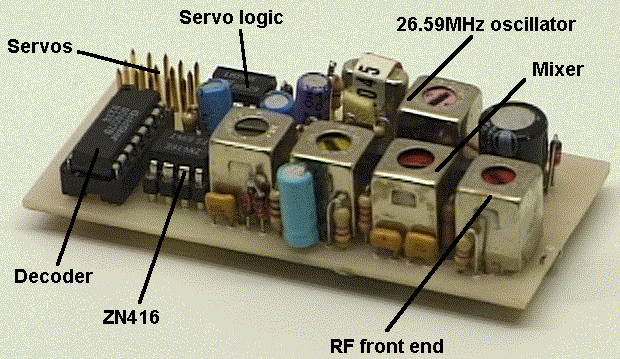Version de Norcim Electronics
Los componentes para hacer este decodificador realmente son muy economicos, estamos hablando de menos de 5 u$d. El circuito responde a los pulsos negativos que provienen desde el receptor. El pulso de comienzo se detecta en el Pin 15 de reset al estar mucho tiempo en estabo bajo; haciendo que el contador 4017 empiece nuevamente a contar los pulsos secuencialmente y dando una salida en alto en Q1, Q2, Q3... etc.Durante el tiempo de sincronismo de aproximadamente 8ms, la carga en el capacitor C1 aumenta hasta que alcanza un valor que resetea el 4017. Algunas versiones mas viejas de 4017 hacen que el reset se produzca mas de una vez causa de un aumento paulatino de la carga en el capacitor; esto se previene con R1 la cual disminuye la velocidad de recambio interna del contador. Los nuevos 4017, no necesitan esta resistencia.
 |
| https://norcim-rc.club/Radio6.htm |
Es posible usar el codificador alimentando directamente el decodificador sin hacer uso de la radio y asi comprobar el comportamiento. Una aplicacion permanente de esto puede ser una camara sumergible propulsada con un motor electrico.
El cableado entre ambos circuitos puede ser muy largo antes de que aparezca un efecto capacitivo porque solo usa dos cables, señal y masa. Por supuesto que en este caso, cada circuito tiene su alimentacion aparte, la cual tiene que ser suficiente en el decodificador para alimentar todos los servos.
Para aquellos que no lo han notado; la entrada del decodificador necesita ser invertida cuando el tiempo de sincronismo esta en estado alto. Un inversor se hace con un transistor y dos resistencias como se muestra en el circuito que sigue.
Version de Harry Lythall SM0VPO
El amplificador operacional "a" amplifica los pulsos entrantes del receptor. Esta etapa es autopolarizada y se puede conectar directamente a la salida de un ZN414Z, ZN416E o cualquier otra salida con un potencial permanente de entre 0 y +6 VCC. Si la salida del receptor está acoplada capacitivamente, tiene un potencial permanente de CC negativo o está conectada a tierra en CC, acople la señal a través de un capacitor de 10 nF y conecte una resistencia de alto valor (470 K - 2 M2) entre los dos puntos marcados con una "X". La salida de esta etapa debe ser una onda cuadrada casi perfecta. Esta onda cuadrada se utiliza para sincronizar el contador del canal y "recargar" la carga de un capacitor.
El amplificador operacional "b" compara la carga del capacitor de "recarga". Durante el período de silencio de 4 ms, este capacitor se descargará, lo que hará que el amplificador operacional "b" reinicie el contador. Tenga en cuenta que la salida 0 del 4017 es una salida de reinicio y las salidas de canal son 1 a 6 (hasta 9). La señal de salida de cada terminal de canal es un pulso único que varía de 600 uS a 1600 uS según la configuración del potenciómetro del canal del codificador.




No hay comentarios:
Publicar un comentario
Hola, muestra tu comentario o duda. Spam o temas que no tienen que ver serán borrados.